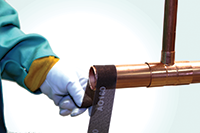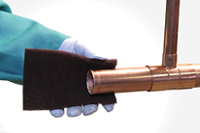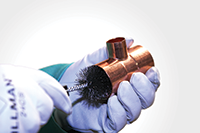The removal of all oxides and surface soil from the tube ends and fitting cups is crucial to proper flow of solder metal into the joint. Failure to remove them can interfere with capillary action and may lessen the strength of the joint and cause failure.
Lightly abrade (clean) the tube ends using sand cloth (Figure 7.6) or nylon abrasive pads (Figure 7.7) for a distance slightly more than the depth of the fitting cups.
Clean the fitting cups by using abrasive cloth, abrasive pads or a properly sized fitting brush (Figure 7.8).
 Figure 7.6. Cleaning: Sand Cloth
Figure 7.6. Cleaning: Sand Cloth Figure 7.7. Cleaning: Abrasive Pad
Figure 7.7. Cleaning: Abrasive Pad Figure 7.8. Cleaning: Fitting Brush
Figure 7.8. Cleaning: Fitting BrushThe capillary space between tube and fitting is approximately 0.004 in. Solder metal fills this gap by capillary action. This spacing is critical for the solder metal to flow into the gap and form a strong joint.
Copper is a relatively soft metal. If too much material is removed from the tube end or fitting cup, a loose fit may result in a poor joint.
Chemical cleaning may be used if the tube ends and fittings are thoroughly rinsed after cleaning according to the procedure furnished by the cleaner manufacturer. Do not touch the cleaned surface with bare hands or oily gloves. Skin oils, lubricating oils and grease impair the soldering operation.
